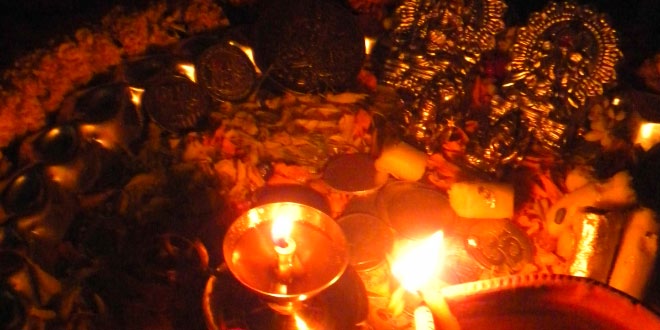Lakshmi Puja on Diwali is an integral part of the Diwali celebrations. This day is also known by the name of ‘Chopada-Puja’. Lakshmi-Puja is performed for the sole purpose of propitiating Goddess Lakshmi and to thank Her for the bestowal of her blessings on the humans. Lakshmi-Puja falls on the darkest night of Amavasya, though with the help of innumerable lamps and diyas this darkness is reduced to such an extent that it seems as if one is celebrating Diwali in broad daylight.
Lakshmi Puja on Diwali is a major part of the Diwali celebration in North and West India. According to the legend associated with Lakshmi Puja, there once occurred the churning of ocean by the demons and the deities in order to look for the ‘amrit‘ or the ‘drink of immortality’. On this day Goddess Lakshmi manifested herself from the ocean and since then Diwali began to be celebrated and Lakshmi Puja became an important part of the Diwali celebrations in order to commemorate the Goddess Lakshmi.
According to a common belief Goddess Lakshmi walks through the green fields as well as the bye-lanes in order to shower her blessings on the human race for peace, wealth and prosperity. Thus everyone is advised to open the doors and the windows of their homes on the eve of Lakshmi Puja.
Step by step procedure of Diwali Lakshmi Pooja:
It is extremely important to keep the house spotlessly clean and pure on Diwali. Goddess Lakshmi likes cleanliness, and she will visit the cleanest house first. This is also the reason why the broom is worshiped on this day with offerings of haldi and kumkum (turmeric and vermilion).
Lamps are lit in the evening to welcome the goddess. They are believed to light up Her path.
Lakshmi Puja consists of a combined puja of five deities: Ganesha is worshiped at the beginning of every auspicious act as Vighnaharta; Goddess Lakshmi is worshiped in her three forms – Mahalakshmi (the goddess of wealth and money), Mahasaraswati (the goddess of books and learning), and Mahakali; Kuber (the treasurer of the gods) is also worshiped.
Spread a new cloth on a raised platform. Place a handful of grains in the centre and, on this, place a kalash (pitcher) made of gold, silver, copper, or terracotta. Fill three-fourth of the kalash with water and place a betel nut, a flower, a coin, and some rice grains in it. Arrange five kinds of leaves or mango leaves in the kalash .
Place a small dish on the kalash and fill it with rice grains. Draw a lotus with turmeric powder (haldi) over the rice grains and place the idol of goddess Lakshmi over it, along with coins.
In front of the kalash, on the right (South-West direction), place the idol of Ganesha. Also place ink and books related to your business or occupation on the platform.
Light a lamp and begin the puja by offering haldi, kumkum and flowers to the platform on which the kalash is placed.
Then offer haldi, kumkum and flowers to the water that is to be used for the puja. Invoke the river goddesses to be part of this water.
Sprinkle this water on all puja utensils to purify them.
Offer haldi, kumkum , and flowers to the kalash on which the idol of Lakshmi is placed.
Invoke Goddess Lakshmi by reciting the Vedic mantras addressed to her. One can also recite the mantras mentioned in the Puranas or simply take some flowers in your hands, close your eyes, and think of Goddess Lakshmi being showered with gold coins by two elephants standing on either side of Her and chant Her name. Then offer the flowers to the idol.
Place the idol of Lakshmi in a plate and bathe it with water, panchamrit (a mixture of milk, curds, ghee or clarified butter, honey and sugar) and then with water containing some gold ornament or a pearl. Wipe the idol clean and place it back on the kalash. Alternately, you can just sprinkle water and panchamrit on the idol with a flower.
 Kids Portal For Parents India Kids Network
Kids Portal For Parents India Kids Network








Thank you so much for the informative post. Very interesting and well-written article on Diwali
Great post! Very helpful reviews with detailed info. Good to read. It will be really helpful for those who don’t know about the celebrations and how to proceed?
Wow such a nice words I have learned more information about the fireworks im also searching the best buy crackers sivakasi to celebrate my festival
This my 3rd article reading about lakshmi pooja. Comparing other two its really informative. thanks for sharing with us.